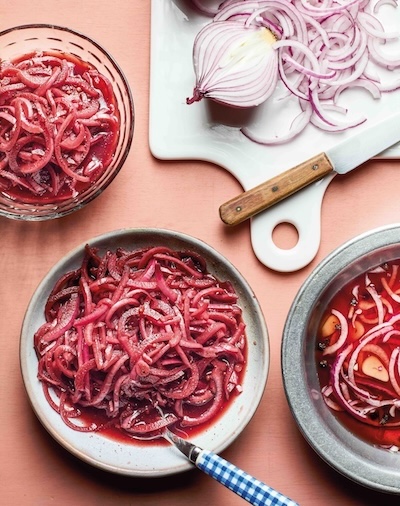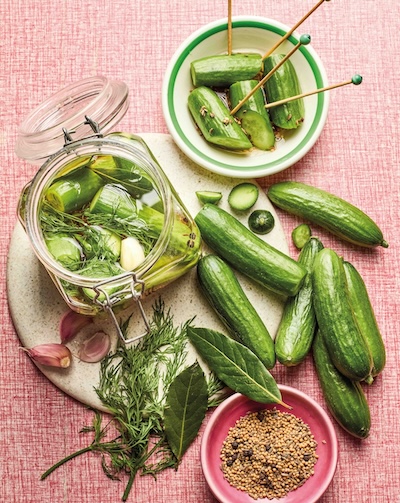Tickle Your Pickle With Shedletskys – Pickle and hot sauce specialists Shedletskys, founded by husband and wife duo James Cooper and Natalie Preston, have just launched their debut cookbook Tickle Your Pickle with Shedletskys How to make (and eat) handmade pickles, ferments and brines. It’s a lovely hardback published by Ryland, Peters & Small at £16.99. We hear a great deal nowadays about how good for us fermented foods are, and this book has all the tools you need to start making your own at home. You can discover 65 recipes that put handmade pickles centre-stage, from classic deli-style dill-pickled cukes and Italian giardiniera to Korean kimchi and South American curtido. Here’s a recipe to ‘tickle your fancy’ and tempt you to invest in the book.
Sweet/sour sumac pickled onions. Makes 1 large jar

“One of Nat’s foundational food memories is her dad’s pickled onions. (Another is liberating a ‘particularly tasty looking and large Spanish onion’ from her parent’s kitchen and eating it in secret in her room over several days, but that’s another story.) This isn’t her dad’s recipe – which is an absolutely classic British interpretation of a pickled onion. Instead, we’ve given our onions a sweet and sour vibe and vaguely Middle Eastern spin through the use of some fruit molasses and a healthy hit of citrus-sharp sumac. The result is something that is as good pepping up a cheese sandwich as it is cutting through a filled pita.”
500 g red onions (about 6 onions)
1 tablespoon salt
350 ml red wine vinegar
100 ml balsamic vinegar
2 tablespoons sour cherry or pomegranate molasses
2 garlic cloves, sliced
100 g brown sugar
1 tablespoon sumac
1/2 tablespoon black peppercorns
Peel and slice the red onions, retaining the bottom ends and outer skins of two of the onions (these help colour the brine and bring a pleasing vibrant pinkness to this pickle). Thinly slice the onions into half-moons. Place these in a colander in the sink and toss with the salt. Leave to drain for about 10 minutes while you prepare the brine.
Place the red wine and balsamic vinegars, molasses, garlic, sugar, sumac and peppercorns into a saucepan and gently heat until the sugar has dissolved and the brine is just starting to simmer.
Turn off the heat, then add the drained onions. Allow them to soften in the residual heat of the brine, stirring occasionally.
Place the reserved onion ends and skins into a large, sterilized jar, followed by the salted sliced onions from the brine. Pour in any additional brine, making sure the onions are completely submerged. Seal the jar and set aside to cool.
Because this pickle is partially cooked, it will be ready to eat in a couple of hours but leaving it in the fridge for a couple of days makes it even tastier. Stored in the fridge, these pickles will be good to eat for at least a month and potentially longer.
Classic deli dill-pickled cucumber. Makes 1 large jar

This is it. The bubbe pickle of Jewish deli culture. It’s the pickle that most people probably think of when you tell them you make pickles for a living. But here’s the thing. For the longest time, we steered clear of making them, especially commercially for Shedletskys. Why? Well, as a pickle that entirely relies on salt to preserve them, they are a little tricky to get right. Relying on a salt brine means that however carefully you sterilize things and keep your surfaces clean, sometimes things go wrong. In a commercial setting, this is a problem. You can get consistency by adding preservatives, but we didn’t want to do that in any of our products. So these incredible pickles remain an at-home treat for us.
Accuracy is critical if you want to give yourself the best chance of success with these pickles. That’s why we always suggest weighing the salt and water used here rather than relying on spoon measurements.
Small Persian cucumbers
(about 1 kg)
50 g salt
3 garlic cloves, peeled and lightly crushed
1 tablespoon black peppercorns
1 tablespoon yellow mustard seeds
1 teaspoon dill seeds (optional)
3 dried bay leaves
2-cm/3/4-inch strip of kombu (optional)
10 g fresh dill fronds
a large 2-litre preserving jar (or something that will comfortably accommodate the cucumbers with about 3 cm/11/4 inches headroom) fermentation weight (or water-filled, sealable plastic sandwich bag)
Slice the bottoms and tops off the cucumbers and place in a large bowl. Fill with very cold water and add a few ice cubes to keep the cucumbers really cold while you prepare the brine. (Keeping the vegetables chilled helps to preserve their crunch later in the pickling process.)
In a separate bowl, measure exactly 1 litre (or 1 kg/21/4 lb. if using a digital scale) water from the tap. Add the salt and whisk vigorously until the salt is completely dissolved. Add the garlic, peppercorns, mustard seeds and dill seeds (if using) to the brine. Stir to distribute everything in the brine.
Remove the cucumbers from their ice bath. Arrange in a large, sterilized jar so they are standing on their ends. Add the bay leaves, kombu (if using) and dill fronds and carefully pour in the brine to cover. Make sure all of the spices go into the jar along with the brine.
Weigh down the cucumbers so they are completely submerged using a fermentation weight or a water-filled, sealable plastic sandwich bag. Leave on the side until bubbles start to form – usually after a couple of days. At this point start testing the pickles. There should be a pleasant, slightly sour taste. This will develop further the longer you leave them. We like our pickles after about a week of fermentation, but feel free to experiment to your own taste.
Once you are happy with how the pickles taste, pop them in the fridge to slow down the fermentation. They will continue to ferment, getting softer and more sour and will still be tasty up to 6 weeks after you made them. (We have had batches that are still delicious 3 months after we made them.)
If at any point the pickles go mouldy or the brine becomes excessively cloudy, discard them and chalk the failed batch down to experience.
The Seasoned Gastronome


